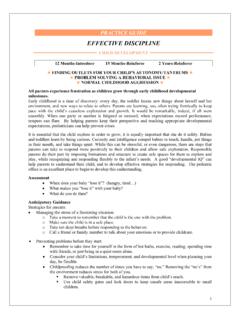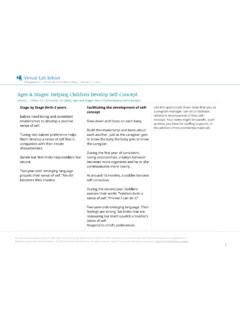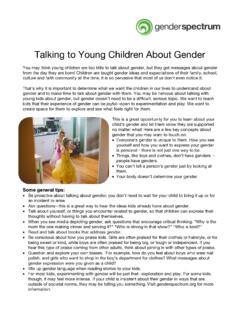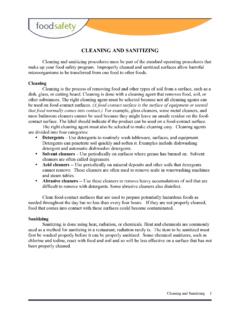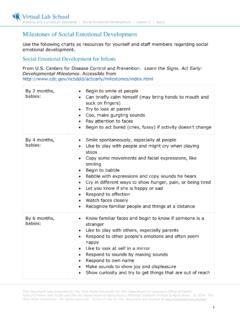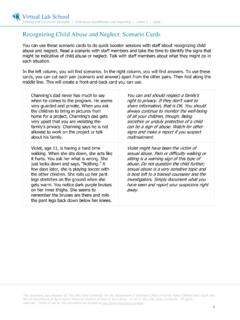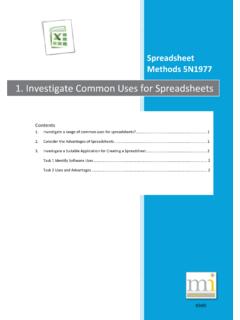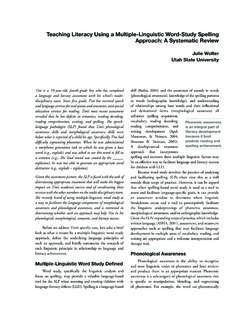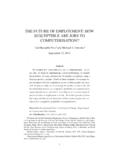Transcription of ELM Curriculum User Guide: Birth to 36 Months
1 ELM Curriculum User Guide: Birth 36 Months3rd EditionDouglas R. Powellwith contributions fromChanele Robinson-RuckerLinn VeenJames ElickerELM Curriculum Development GroupPurdue UniversityDouglas R. Powell, Principal InvestigatorShelley MacDermid Wadsworth, Co-Principal InvestigatorChanele Robinson-Rucker, Project ManagerContent Experts Sue Bredekamp, Developmentally Appropriate PracticeKaren Diamond, Language/LiteracyJames Elicker, Infant-ToddlerPanayota Mantzicopoulos-James, ScienceCatherine Mogil, Social-Emotional Megan Purcell, Social Studies and Creative ExpressionDavid Purpura, Mathematics Sara Schmitt, Self-Regulation and Social-EmotionalWriters of Activity Plans and Related Resources Birth 36 MonthsLinn VeenSara LaneChanele Robinson-RuckerRena SterrettAmy CarlatDouglas Powell, Editor 3 5 Years Rena Sterrett Amy CarlatKathy BroniarczykMegan PurcellBarbara BeaulieuKaren DiamondDouglas Powell, EditorGraphic DesignerMargaret MartinEditorial and Graphic Design AssistantsBethann SchroederJah-Sahrrang HortonRuth WasmuthSuggested Citation for ELM Curriculum : ELM Curriculum Development Group (2018).
2 Early Learning Matters (ELM) Curriculum . West Lafayette, IN: Purdue University. Suggested Citation for ELM Curriculum User Guide: Birth 36 Months : Powell, D. R. with Robinson-Rucker, C., Veen, L., & Elicker, J. (2019). ELM Curriculum User Guide: Birth 36 Months . West Lafayette, IN: Purdue ELM at: Development of the Early Learning Matters (ELM) Curriculum was supported by the Department of Defense Child Development Competitive Program of the Department of Agriculture s National Institute of Food and Agriculture (NIFA), grant number 2013-48762-21537 to Purdue University as part of the DoD-USDA Partnership for Military Families. The ELM Curriculum is based in the Department of Human Development and Family Studies, Purdue University, West Lafayette, Indiana 47907-2055. Douglas Powell, Principal Investigator. Shelley MacDermid Wadsworth, Co-Principal Investigator. Copyright 2019 The Trustees of Purdue University. All rights 2019 The Trustees of Purdue UniversityAll Rights ReservediTable of ContentsIntroduction to the ELM Curriculum : Birth 36 Months .
3 1 Birth to Three Years as a Distinct Period of Development ..1 Key Characteristics of ELM: Intentional, Meaningful, Plentiful ..3 Intentional ..3 Meaningful ..6 Plentiful ..7 ELM s Starting Points ..8 Developmentally Appropriate Practice ..8 Guidance from Research Evidence and Experts ..8 Pilot Testing ..9 Staff Credentials and Turnovers ..9 Areas Promoted by ELM ..12 Communication/Language ..12 How ELM Promotes Communication and Language Development ..13 Exploring Words ..13 Exploring Sounds ..14 Building on the Activity Plans ..14 More Practices for Promoting Communication and Language ..14 Strengthening Your Understanding of Communication and Language ..15 Cognitive ..17 How ELM Promotes Cognitive Development ..17 Exploring Objects ..18 Solving Problems ..19 Sorting and Matching ..19 Building on the Activity Plans ..19 More Practices for Promoting Cognitive Development ..19 Strengthening Your Understanding of Cognitive Development ..20 Self-Regulation ..22 How ELM Promotes Self-Regulation.
4 23 Getting Calm ..23 Paying Attention ..24 Focusing and Remembering ..24 Copyright 2019 The Trustees of Purdue UniversityAll Rights ReservediiTable of ContentsAreas Promoted by ELM: Self-Regulation continuedBuilding on the Activity Plans ..25 More Practices for Promoting Self-Regulation ..25 Strengthening Your Understanding of Self-Regulation ..25 Social-Emotional ..27 How ELM Promotes Social-Emotional Development ..28 Interacting with Others ..28 Exploring Feelings ..28 Building on the Activity Plans ..29 More Practices for Promoting Social-Emotional Development ..29 Strengthening Your Understanding of Social-Emotional Development ..29 Physical/Health ..31 How ELM Promotes Physical Development and Good Health Practices ..32 Moving Our Bodies ..32 Using Our Hands ..33 More Practices for Promoting Motor Development and Good Health Practices ..34 Strengthening Your Understanding of Motor Development and Good Health Practices ..35 Sequence of Skills and Learning Goals ..37 Birth 12 Months .
5 3812 24 Months ..4324 36 Months ..48 Effective Use of ELM: Birth 36 Months ..53 How to Use Activity Plans ..53 Organization ..53 Components ..54 Selecting Activity Options ..55 Examples of Caregiver Selections of Activity Options for Infants ..56 Examples of Caregiver Selections of Activity Options for Toddlers ..57 Adapting Activity Options ..58 Planning Form ..59 Daily Schedule Considerations ..60 Preparing the Environment ..61 Inviting and Supporting Participation ..62 Copyright 2019 The Trustees of Purdue UniversityAll Rights ReservediiiTable of ContentsEffective Use of ELM: Birth 36 Months continuedPace and Presence ..63 Caregiver Talk ..64 Guidelines ..65 Quality of Implementation ..66 Observing and Supporting Children s Progress in Developing Foundation Skills ..67 Observation Guides ..68 Follow-up Plans ..69 Connecting with Families ..71 Readiness Starts Early ..72 Tools for Sharing Child-Specific Progress Information ..72 Training Resources ..73 Basic Training Plan: Five Key Steps.
6 73 ELM Online Trainings ..73 ELM Activity Observation Checklist ..74 Example of an Activity Observation and Coaching Session with a Caregiver ..76 Appendix ..78 ELM Planning Form: Week of _____ Sample ..79 Guide for Observing and Individualizing: Fine Motor Development Sample ..80 ELM Snapshot of Child Progress: Birth 12 Month Sample ..86 ELM Activity Observation Checklist Sample ..88 Introduction to the ELM Curriculum : Birth 36 MonthsCopyright 2019 The Trustees of Purdue UniversityAll Rights Reserved1 Introduction to the ELM CurriculumBirth 36 MonthsThe Early Learning Matters (ELM) Curriculum is a comprehensive, research-informed program to support the optimal learning and development of children from Birth to five years of age. The Curriculum promotes skills linked to school readiness and life success with the best practices available. The practices include developmentally appropriate teaching strategies and the proven benefits of a coordinated mix of staff-guided and child-initiated learning experiences.
7 ELM offers practical, easy-to-use resources designed to support a range of staff backgrounds and to support children s learning in is based on results of rigorous research on early childhood programs that enable young children to get off to a good start in school and in life. The Curriculum is also based on the developmentally appropriate practice position statement1 and program accreditation standards2 of the National Association for the Education of Young Children (NAEYC). The development of ELM included pilot testing in military child development centers and in-depth reviews of Curriculum plans by prominent early childhood content experts and program was developed by Purdue University for the Department of Defense Child Development Program and civilian programs of early care and education. The Curriculum is available free of charge at the Virtual Laboratory School ( ). Information about ELM may be requested at: ELM s resources for supporting the development and learning of children Birth to 36 Months of age are the focus of this User Guide.
8 There is a separate User Guide for working with children 3 5 years of age. Birth to Three Years as a Distinct Period of DevelopmentThe first three years of life have long been viewed as a distinct period that provides the foundation for later development. Studies show that school readiness and positive life outcomes begin in Early growth is rapid and consequential in all major areas of development, including the following: ybrain development, especially rates of neural connections ymotor and perceptual skills that enable infants and toddlers to actively explore their worlds yregulation of behaviors, emotions, and thoughts yquality of interactions and relationships with others ycommunication and language abilities, and ythinking skills related to explorations of objects and solving remarkable amounts of change that occur in infants and toddlers offer unique opportunities to influence Experts recommend program approaches that build on distinguishing characteristics of learning and development in the early Particularly valuable are responsive interactions and flexible experiences that encourage individual children to pursue their interests and stretch toward what they do not yet know or cannot yet Experiences that effectively support the learning and development of infants and toddlers are qualitatively different than developmentally appropriate experiences for preschool-age children.
9 This principle is represented in emerging definitions Copyright 2019 The Trustees of Purdue UniversityAll Rights Reserved2 Introduction to the ELM Curriculum Birth 36 Monthsof curricula for infants and toddlers,7 and is firmly reflected in the design of the ELM Curriculum . The configuration of activities helps caregivers tune in to a child. The vast majority of ELM activity options for infants are one-to-one experiences, for example. Activities that involve a gathering of children are generally small and always flexible in amount and type of participation. Learning activities offered in the ELM Curriculum include options and adaptation suggestions for individualizing experiences. There is extensive guidance on ways to accommodate a child s interests and abilities prior to and during an activity. The activities are to be embedded in a daily schedule that is predictable and flexible, and used in the context of secure relationships among caregivers and children. ELM activities support specific areas of development with play- based experiences while recognizing all areas of development are interrelated.
10 Activity goals emphasize process, not fixed outcomes, and are written from the perspective of a child s experiences. The activity descriptions include a range of caregiver strategies for promoting a child s explorations. ELM activities are organized by sequences in which infants and toddlers typically develop skills and knowledge. ELM reflects early childhood experts recommendation that a connected, integrated Curriculum is more effective than a Curriculum that introduces content in small, unrelated At the same time, the design of the Curriculum assumes development often does not proceed in a straight line and that there are considerable differences across children in rates of development. The period of Birth through 36 Months involves more routine care activities than later periods of development. The work of infant-toddler program staff entails both teaching and caregiving. The Areas Promoted by ELM section of this Guide includes suggestions for incorporating supports for learning and development into basic care routines, especially mealtimes, transitions to rest, and diapering.
